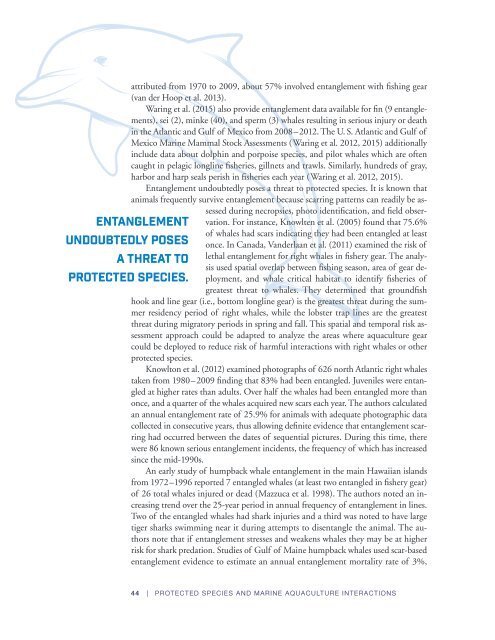Protected Species and Marine Aquaculture Interactions
x9Jh2
x9Jh2
You also want an ePaper? Increase the reach of your titles
YUMPU automatically turns print PDFs into web optimized ePapers that Google loves.
attributed from 1970 to 2009, about 57% involved entanglement with fishing gear<br />
(van der Hoop et al. 2013).<br />
Waring et al. (2015) also provide entanglement data available for fin (9 entanglements),<br />
sei (2), minke (40), <strong>and</strong> sperm (3) whales resulting in serious injury or death<br />
in the Atlantic <strong>and</strong> Gulf of Mexico from 2008– 2012. The U. S. Atlantic <strong>and</strong> Gulf of<br />
Mexico <strong>Marine</strong> Mammal Stock Assessments (Waring et al. 2012, 2015) additionally<br />
include data about dolphin <strong>and</strong> porpoise species, <strong>and</strong> pilot whales which are often<br />
caught in pelagic longline fisheries, gillnets <strong>and</strong> trawls. Similarly, hundreds of gray,<br />
harbor <strong>and</strong> harp seals perish in fisheries each year (Waring et al. 2012, 2015).<br />
Entanglement undoubtedly poses a threat to protected species. It is known that<br />
animals frequently survive entanglement because scarring patterns can readily be assessed<br />
during necropsies, photo identification, <strong>and</strong> field observation.<br />
For instance, Knowlten et al. (2005) found that 75.6%<br />
of whales had scars indicating they had been entangled at least<br />
once. In Canada, V<strong>and</strong>erlaan et al. (2011) examined the risk of<br />
lethal entanglement for right whales in fishery gear. The analysis<br />
used spatial overlap between fishing season, area of gear deployment,<br />
<strong>and</strong> whale critical habitat to identify fisheries of<br />
greatest threat to whales. They determined that groundfish<br />
hook <strong>and</strong> line gear (i.e., bottom longline gear) is the greatest threat during the summer<br />
residency period of right whales, while the lobster trap lines are the greatest<br />
threat during migratory periods in spring <strong>and</strong> fall. This spatial <strong>and</strong> temporal risk assessment<br />
approach could be adapted to analyze the areas where aquaculture gear<br />
could be deployed to reduce risk of harmful interactions with right whales or other<br />
protected species.<br />
Knowlton et al. (2012) examined photographs of 626 north Atlantic right whales<br />
taken from 1980–2009 finding that 83% had been entangled. Juveniles were entangled<br />
at higher rates than adults. Over half the whales had been entangled more than<br />
once, <strong>and</strong> a quarter of the whales acquired new scars each year. The authors calculated<br />
an annual entanglement rate of 25.9% for animals with adequate photographic data<br />
collected in consecutive years, thus allowing definite evidence that entanglement scarring<br />
had occurred between the dates of sequential pictures. During this time, there<br />
were 86 known serious entanglement incidents, the frequency of which has increased<br />
since the mid-1990s.<br />
An early study of humpback whale entanglement in the main Hawaiian isl<strong>and</strong>s<br />
from 1972– 1996 reported 7 entangled whales (at least two entangled in fishery gear)<br />
of 26 total whales injured or dead (Mazzuca et al. 1998). The authors noted an increasing<br />
trend over the 25-year period in annual frequency of entanglement in lines.<br />
Two of the entangled whales had shark injuries <strong>and</strong> a third was noted to have large<br />
tiger sharks swimming near it during attempts to disentangle the animal. The authors<br />
note that if entanglement stresses <strong>and</strong> weakens whales they may be at higher<br />
risk for shark predation. Studies of Gulf of Maine humpback whales used scar-based<br />
entanglement evidence to estimate an annual entanglement mortality rate of 3%,<br />
Entanglement<br />
undoubtedly poses<br />
a threat to<br />
protected species.<br />
44 | ProtEctEd SPEciES <strong>and</strong> MarinE aquaculturE intEractionS


